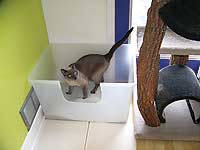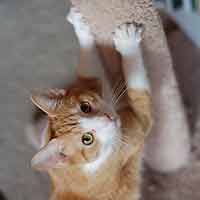The domestication of cats seems to be more a mutual understanding rather than an intentional human act. We chose to bring wolves into our lives and turned them into our loveable canine companions, but cats just basically started hanging around and we never told them to leave. We have made far more of an impact on dogs too, making hundreds of different breeds, where cats have stayed much closer to their ancestors with little variation. Another testament to cats resilience to be themselves regardless of our efforts as human companions (I would never even try to say owner; my cats wouldn’t allow it). Sometimes the relationship between cats and humans can be contentious, but let’s face it they are here to stay. So how can we make living with cats easier on us, here are a few things you can do to improve your living arrangement with your furry feline friends.
Urine marking indoors: First things first, clean the area with an enzymatic product that will destroy the uric acid. If you can smell it but can’t find the urine, use a black light in the dark. Cat urine glows under a black light.
Once you have addressed the urine, consider why you cat may be marking. Cats often pee indoors whenever they are feeling insecure of their territory and so they mark it the only way that they know how- they pee. Have you noticed the specific areas where your cat seems to spray? In most homes, that is near a window or anywhere that a cat feels threatened. If you haven’t already, determine where your cat sprays often. That will be the place where your efforts will take place.
One way to make your cat feel more relaxed in that area is (believe it or not) by helping him or her spread the cat smell in the area. Here’s a simple trick. Get a damp cloth, rub it on your cat (this will get some of the smell) and then rub it on to the area where your cat usually pees. That way, when your cat feels insecure there, he or she will feel no need to pee because their smell is already there, marking the territory.
If the area of marking is near the cat box, but not in the cat box make sure the box is clean (once a day at minimum) or large enough to for your cat. Small targets make for tough aiming. If you have a multi cat household, you may need more than one box. Often cats do not like to share a box, so offer another box if your cats are making a mess.
If all else fails make sure your cat is feeling well. If your cat is going everywhere other than the box and territorial marking, and box problems have been addressed it may be time for a trip to the vet.
Meowing and cat crazies at night: Cats have some nocturnal behaviors that conflict with our very human need to sleep at night. This can make Fluffy a nighttime terror. There are a few things that can keep your cat at bay while you are trying to get a full 8 hours in at night. First, is simple and pretty important. After dinner and before bed is the best time to engage in some vigorous play with your cat. Chasing a wand toy can help get out any excess energy your cat has before its bedtime. Cats sleep on average 18 hours a day, so make the waking hours count. Cats are made to have a burst of energy then sleep it off, so small efforts can reap big rewards if you time it right.
Second trick to keeping the cat quiet while you are asleep is a meal right before bedtime. Cats sleep the longest just after a meal, so the closer their meal is to your bedtime the more likely they will stay quiet at night. I even leave a snack out for the cats, so if they get hungry in the early morning hours they have something to snack on before my feet hit the floor.
Third trick is to have a toy to play with that is as far away from the bedroom as possible. There are many door toys, and automated toys that can be placed on the other side of the house to keep those midnight cat crazies occupied. Also using a treat ball can keep them occupied for a while. It helps them hunt for calories and can often keep them out of your hair (literally) while you sleep.
Scratching: There are things that you need to say yes to, and things you need to say no to, to make your home an even playing field for your cats natural instincts to be met and having nice furniture.
Say yes to appropriate places for your cat to let out his scratching. You do need to make the offendin g area of scratching less pleasant, but there must also be a place where scratching feels good and garners your praise. We recommend not only a scratching post, but several, depending on how many areas he likes to scratch on already. g area of scratching less pleasant, but there must also be a place where scratching feels good and garners your praise. We recommend not only a scratching post, but several, depending on how many areas he likes to scratch on already.
Saying no by using the following methods will help break the cat of the habit of scratching inappropriate objects (your furniture) by removing the pleasurable component and replacing it with something not quite so nice.
tin foil covering the spot they scratch
double-sided packing tape (or the name brand Sticky Paws)
vinyl carpet runner with the spike side up in front of the spot
But remember, aversive methods will only work when the cat is provided with an alternate surface that is equally or more desirable.
Cat condos/trees are beneficial in many ways, one of which is to provide a common marking post in multi-cat households. Not all cats need the expensive stuff; some are a cheap date for sure. Make sure you are catering to your feline friend’s particular preferences. There are inexpensive horizontal cardboard scratchers for carpet–lovers, wedge shaped cardboard ramps for cats that scratch low on furniture, and upright posts/trees for cats who like that full body hang from the claws feeling. The material that the post is made of is also important. Many cats prefer the feel of a sisal rope covered post, and natural wood is also desirable in that it closely mimics what they’d like to scratch most of all, trees! A redwood or cedar (softwood) plank or log may be a real hit. Beware of carpet covered furniture, mainly because it’s hard to teach your cat that scratching “this” carpet is okay, but “that” carpet isn’t.
Life with small predators is nothing less than challenging at times but when these sweet furry friends are happy, they are excellent companions. Make sure you provide good quality food, fresh water and clean litter box to get the best out of your cat. May you have a peaceful night’s rest, and a calm shred-free home.
|